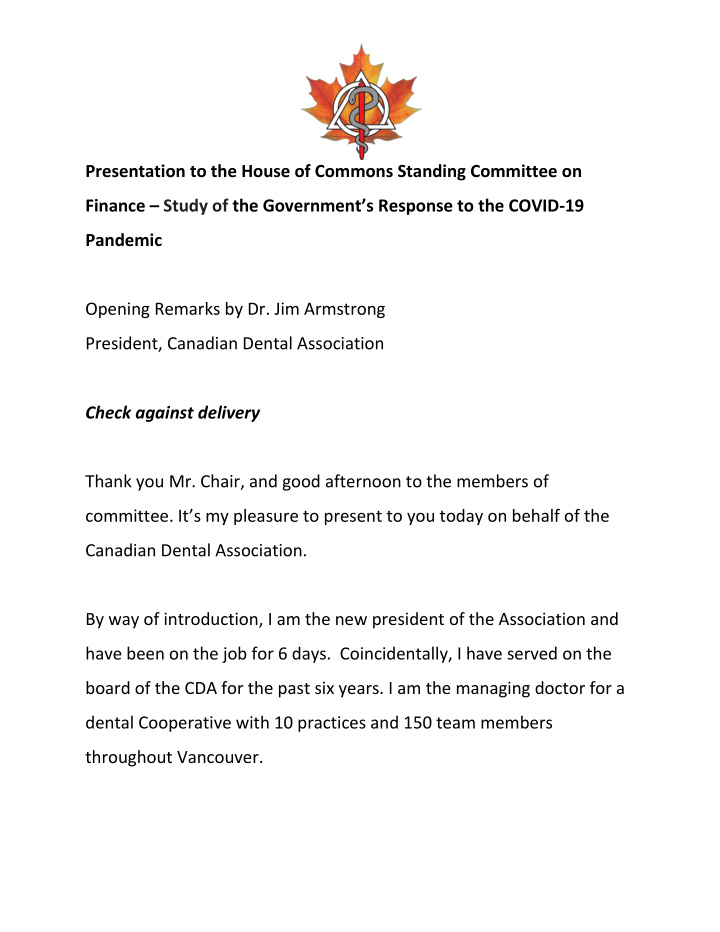



Presentation to the House of Commons Standing Committee on Finance – Study of the Government’s Response to the COVID-19 Pandemic Opening Remarks by Dr. Jim Armstrong President, Canadian Dental Association Check against delivery Thank you Mr. Chair, and good afternoon to the members of committee. It’s my pleasure to present to you today on behalf of the Canadian Dental Association. By way of introduction, I am the new president of the Association and have been on the job for 6 days. Coincidentally, I have served on the board of the CDA for the past six years. I am the managing doctor for a dental Cooperative with 10 practices and 150 team members throughout Vancouver.
As well, I am an Adjunct professor at the Sauder School of Business at UBC, and the former chair of the economics committee at the British Columbia Dental Association. I have been a student of strategy and public policy for over 40 years. My academic interests are econometric models, disruptive innovation and AI From that perspective, I can tell you that the COVID-19 outbreak and the ensuing shut down have had a particularly negative impact on dentistry. This pandemic has brought two hitchhikers. A liquidity crisis and a solvency crisis. Dentistry is almost entirely a fixed cost business, and the debt to finance our own dental practices is significant. Thus, when people have no money, all dental practices have a liquidity crisis. Given the magnitude of the problem, many dental practices now face a solvency crisis. When the pandemic hit, dentistry was shut down under the orders of the regulatory bodies in their respective provinces. Early in the pandemic all hospitals were critically short of PPEs and dentists across the country stripped their offices of PPEs to donate to their local 2
hospitals Most critically, in order to keep patients out of hospital emergency rooms, dentists, as essential services, provided emergency procedures to patients in pain, with swelling or with infection. There was minimal billing of patients or no charges for these important services. Importantly, though, these few procedures are not nearly enough to sustain a dental practice. I am deeply appreciative of the government’s support of both liquidity and solvency issues for small business. The challenge has been historic. The programs that have been made available to businesses and to workers affected by the shut down have helped to mitigate some of the worst possible outcomes. There are obviously difficulties that arise in trying to create programs that cover many different businesses, and then having individual businesses attempt to understand how they fit their particular situation. There are more than 18,000 dental offices across the country, and they operate in a multitude of business models. There is no road map back from a pandemic, nor is there a playbook as to what should be the stimulus packages to ensure Canadians have companies and jobs to return to. 3
Given the circumstances, we greatly appreciate the government’s willingness to be flexible and adapt the programs based on the feedback they receive. At this point, I think it is important that we begin to pivot and to look ahead at what comes next. The programs that were rolled out were intended to protect Canadians (supply side) to keep the economy afloat through a critical period. A Keynesian moment if there ever was one. Now, we must consider what we will need to help us through this next phase as the economy re-opens. In the coming weeks, dental offices will begin to open across the country, in accordance with the guidance set out by their provincial regulators. But it will be anything but business as usual. Dental offices are essentially mini-hospitals. Like any hospital we follow strict infection control procedures and practices. As dental offices begin to provide services again in the coming months, they will need to take on a multitude of new and additional costs. 4
These costs include enhanced PPE for staff, and may require physical changes to the office as well. We are still grappling with some of these questions. These new costs cannot be defrayed by adding to the cost of services. Furthermore, in order to maintain safety, we will not be as productive as in the past: we will not be capable of seeing as many patients per day as we did previously. Moreover, we are greatly concerned that these new costs will come at a time when some patients may not return to dental offices. Some people will be more reluctant to visit any health care provider, either for health or financial reasons. Consequently, they may postpone treatment until the pain or infection requires that they go to the hospital emergency room. As we look ahead, dentistry would be appreciative if the Government of Canada would consider the following: 1. An extension of the eligibility period for the Canada Emergency Wage Subsidy. Many dental offices will only be re-opening in the coming weeks, and will need to bring back staff slowly over the 5
coming months. An extension of this program would be significant help to dental practices 2. Recognize the challenges of retooling and re-establishing dental offices, and to ensure that we have the ability through grants or tax credits to defray some of these costs to help us better serve the public, and keep Canadians healthy. 3. Government support to help more Canadian businesses provide Extended Health Care benefits. This would help Canadians access needed dental, psychological, vision, chiropractic and physiotherapy services after a time of severe stress. The lock- down has taken its toll on our oral health as well as on our physical and mental well-being. 4. Currently during this pandemic, Governments cover the cost of PPEs for public hospitals It would be greatly appreciated if provincial dental associations could have access to a guaranteed supply of these PPEs at no cost for distribution to their members. Thank you, and I would be happy to take any questions. 6
Recommend
More recommend